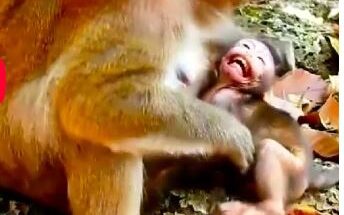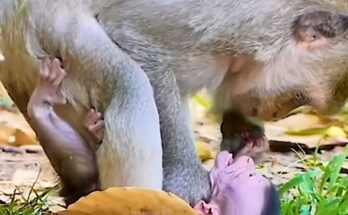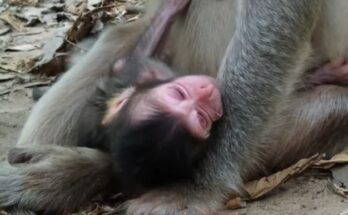In the animal kingdom, weaning is a crucial phase in a young animal’s development, signaling the transition from reliance on maternal milk to the consumption of solid food. For primates, including monkeys, this process is not only about nourishment but also learning critical survival skills. Among monkeys, the way a mother helps guide her baby toward solid food is a complex, interactive process that involves a blend of maternal care, social learning, and gradual exposure to new foods. These milestones represent important steps in a young monkey’s journey toward independence and survival.
The Early Days: Dependency on Maternal Milk
In the early stages of life, a baby monkey is completely dependent on its mother for nutrition. Like many mammals, the infant will rely on breastfeeding for the first several months of life. This milk provides essential nutrients, antibodies, and energy needed for growth and development. During this time, the mother establishes a bond with her baby, which is crucial for the baby’s emotional and social development. The infant monkey will spend most of its time clinging to its mother, staying close for warmth, protection, and access to milk.
Gradual Introduction to Solid Foods
Around the age of 3 to 6 months, a baby monkey begins to show interest in solid food. This marks the beginning of the weaning process. The mother plays a pivotal role in introducing her baby to solid foods. Initially, the baby will observe its mother eating and show curiosity about the foods she consumes. It is not uncommon for the mother to start eating in front of the baby, gradually allowing the infant to see, smell, and even taste a variety of foods. This observation phase is crucial because it teaches the baby what is safe and appropriate to eat.
At this stage, the mother may begin offering small amounts of solid food to the baby, sometimes gently placing it near the infant’s mouth. The baby may initially show hesitation or confusion, as the transition from milk to solid food requires a significant adjustment. The baby’s instinctual behaviors, such as exploring objects with their mouth, eventually guide them to understand how to chew and swallow solid foods.
Social Learning and Imitation
Monkeys, like many social animals, are heavily influenced by social learning. As the baby watches its mother and other group members consume various foods, it begins to learn which foods are edible and how to eat them. This process is vital for the baby to develop the necessary skills for foraging and eating independently. By observing the adults in the group, the infant learns how to manipulate food, which fruits, leaves, and insects are safe to eat, and which ones should be avoided.
The role of social learning is critical not just for dietary habits but also for understanding the importance of food in their social environment. Many monkey species live in tight-knit groups, and sharing food is often part of the social structure. The baby will also witness the social behaviors associated with food, such as sharing or defending food, which are important lessons for later in life.
Reducing Dependency: The Weaning Phase
As the baby begins to accept solid food and eat more on its own, the mother gradually reduces the frequency of breastfeeding. Weaning is not an abrupt process; it is a slow transition where the mother still provides milk, but the infant starts eating more solid food. The mother may deliberately limit breastfeeding sessions, forcing the baby to rely more on the food available in the environment.
This phase is often accompanied by behavioral changes. The baby may become more independent, spending time foraging or exploring food on its own. While the mother may continue to supervise and guide her baby, she allows it to take more responsibility for its own nourishment. In some species, mothers may even begin to teach their babies how to find and gather food, further increasing the baby’s skills and independence.
The Final Stages: Full Weaning
The final stages of weaning occur between 9 to 18 months of age, depending on the species. By this time, the baby is fully capable of eating solid food and may begin to rely solely on what it can find and consume independently. The emotional bond between mother and child during this period often remains strong, as the mother provides guidance and protection, but the baby is gradually becoming more self-sufficient.
At the end of the weaning process, the mother monkey’s role shifts. The baby has now entered the next stage of development, where it will rely on its growing social group and foraging skills to survive and thrive.
In conclusion, the weaning process for a baby monkey is a delicate balance of maternal care, gradual exposure to solid foods, and social learning. By guiding their infants through these milestones, mother monkeys ensure that their young are equipped with the skills necessary for survival and independence in their complex social and environmental world.


